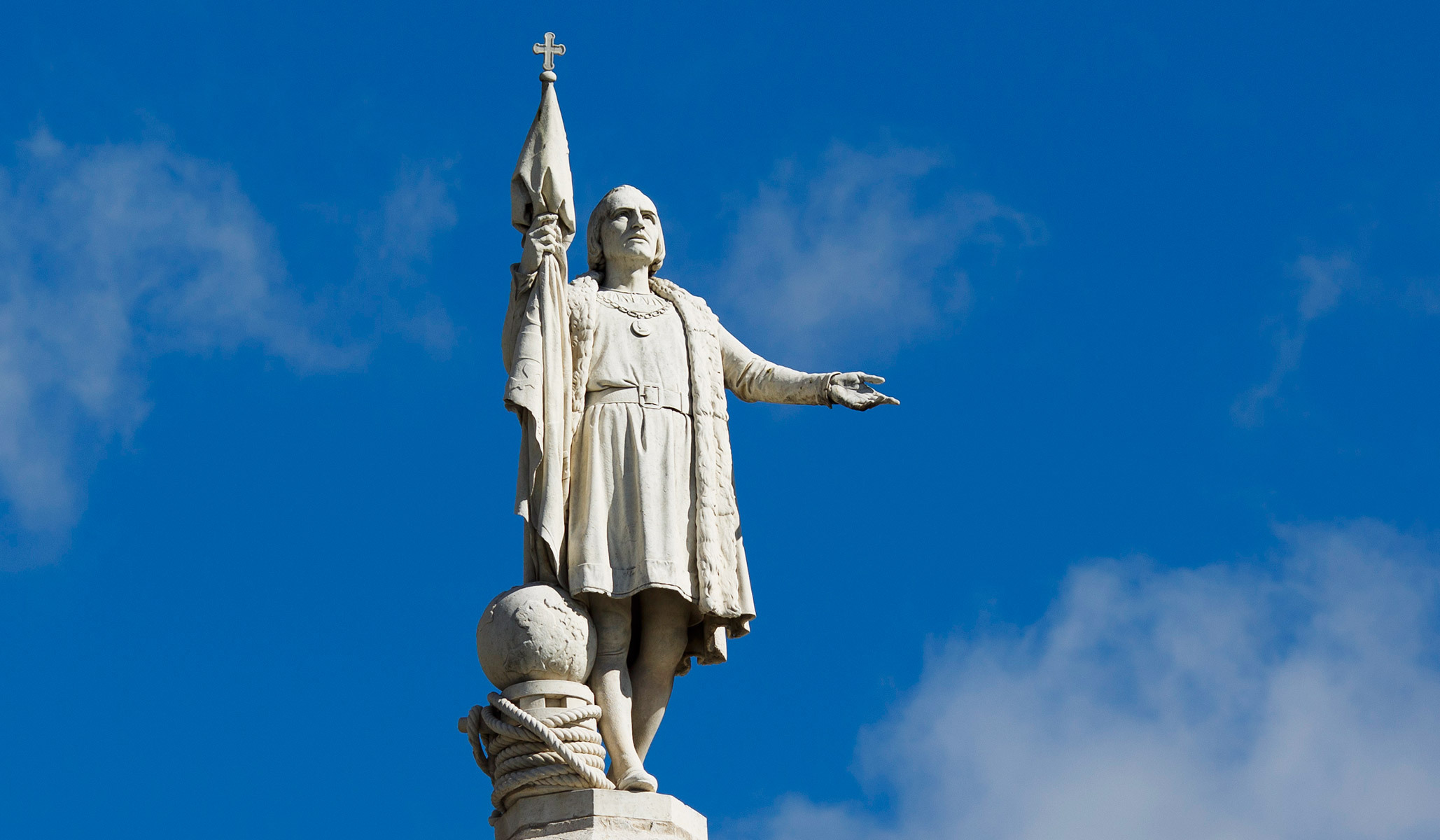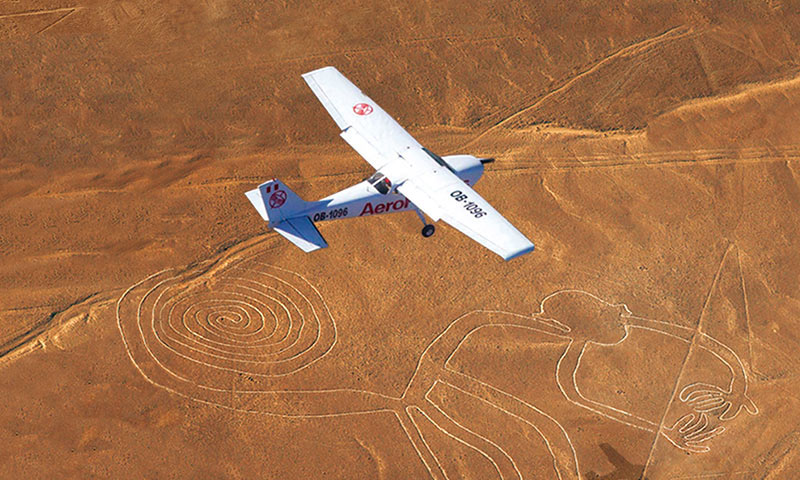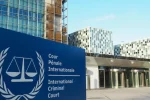IS COLUMBUS THE FIRST VOYAGER TO THE NEW WORLD?

Was transoceanic seafaring a European monopoly?
As we all know, Christopher Columbus, the 16th century Italian explorer and navigator from Genoa, is credited with the discovery of the New World, but now this fact seems to be losing ground, as a growing number of reputable academics tend to cast doubt on it. An overwhelming body of archaeological and historical evidence shows that many other nations too had reached the shores of the Americas well before Columbus. Yet, the opponents of this theory, describing such evidence as circumstantial or ambiguous, have dismissed the pre-Columbian transoceanic voyages as pseudohistory or fringe science.
Although the conserved oral, written and pictorial traditions of the Native Americans with regard to their original home have nothing to do with Asia, most anthropologists now agree that the forebears of the Amerindians crossed over the land bridge-the then frozen Bering Straits-from Siberia to Alaska tens of thousands of years ago and eventually populated the Americas from Alaska to the southern tip of Tierra del Fuego in South America. Many still retain racial features typical of the Mongoloid (Chinese) people, namely, thin eyes, straight black hair, broad faces and heads. Strangely, some of them founded great empires in Mexico and Peru while others have remained in a primitive state even to this day as wild tribes as in the case of the dwellers in the Amazonian jungles. Hence, these Amerindians are considered to be the earliest settlers in the Americas.

African voyagers before Columbus
Thousands of years before Christopher Columbus (1451-1506) the West Africans and ancient Egyptians travelled to the New World, contributing immensely to the early Olmec culture in Mesoamerica (Central America) by introducing the art of pyramid-building, mummification, mythology, writing, mathematics and even a sophisticated calendar. Despite the general notion, the Africans were skilled and intrepid mariners who crossed the surging waters of the Atlantic Ocean in their primitive boats, depending on currents, without an oar, rudder or sail, as demonstrated by modern attempts to prove such navigation. Leo Wiener (1862-1939), an American historian and linguist of Polish-Jewish origin, in his book on this subject (1920), wrote that Columbus himself had quoted in his journal the Amerindians who had told him that black-skinned people had come from the south-east, trading in gold-tipped spears.
Carved colossal heads, some weighing about 24 tons and standing about 2 m, excavated at Tres Zapotes in Central Mexico, have been attributed to the aforesaid Olmec culture (dating back to 1200 B. C.), which predated that of the Aztecs, Mayas and Incas. The heads in question depict an unerringly (African) Negroid features. Ivan Gladstone Van Sertima (1935-2009), a Guyanese-born British professor of African Studies and Michael Douglas Coe (1929-2019), a leading American historian, are of the opinion that later Mesoamerican civilisations were based on the Olmec culture.
It is said that in 1311 A. D. King Abu Bakr II, the ruler of the West African Mali Empire (1235-1670), sent out a large fleet of ships of trade material (crops, animals, cloth, etc.) along with African knowledge of astronomy, religion and arts. But critics refute this story, saying that such a king never reigned and they attribute the voyage instead to Muhammad Ibn Qu, the eighth Sultan of the empire, who led a marine expedition into the Atlantic Ocean never to return. However, Van Sertima and the Malian researcher Gaoussou Diawara suggested that the voyage did reach the New World. The former even suggested that the Aztec god Quetzalcoatl was a visitor from Africa (he faced severe criticism from mainstream scholars for this theory) and Wiener drew similarities between the West African Mandinka ethnic community and Mesoamerican religious symbols like the winged serpent and the sun disk.
The Greek historian and geographer Herodotus (484 B. C. – 425 B. C.) recorded in 445 B. C. the seafaring skills of the ancient Pharaohs. Black Egyptians, under the guidance of King Ramses III, who reigned from 1186-1155 B. C., sailed to the Americas and settled there. In 1992 the toxicologist Svetlana Balabanova found in Egyptian mummies traces of cocaine, hashish and nicotine, known to be derived from plants native to the Americas, which suggested that the Ancient Egyptians could have acquired these narcotics only via trade with the Native Americans. Other curiosities that would support the transatlantic voyages are the Egyptian artifacts from North America and Algonquin writings of Eastern Canada as well as Egyptian place names in the Grand Canyon.
Prof. Everett Borders points out the nature of the American pyramids as a strong indication of the African presence: pyramids of the Egyptian and Olmec cultures were both placed on the same north-south axis and the construction methods were strikingly identical. All these pyramids, tellingly, served the same dual purpose: tomb and temple.

Are Phoenicians the first voyagers to the New World?
The Phoenicians, an ancient Semitic-speaking people of the Near East, were the finest sailors of the ancient world. Originating in the eastern Mediterranean region in modern Lebanon, they claimed that they were the first discoverers of the Americas. Even Diodorus Siculus (90 B. C.-30 B. C.), the ancient Greek historian, agreed with their claim. The proponents of this theory have offered a number of evidences, among them the famous world map, compiled in 1513 by the Turkish admiral and cartographer Piri Reis (1465-1553), which shows the coast of Brazil with reasonable accuracy, including the Azores and Canary Islands in the Atlantic Ocean and possibly Japan as well. The surviving fragment of the map, drawn on gazelle skin parchment and presently kept in a museum in Istanbul, Turkey was compiled from older charts of world maps that were housed in the giant library at Alexandria before a fire destroyed it completely in 47 B. C.
The American palaeontologist Mark McMenamin (born in 1957) proposed that Phoenician navigators reached the shores of the New World around 350 B. C. and the Phoenician state of Carthage in present-day Tunisia minted coins which, according to him, bore a map showing the Americas. But later, he found that these coins were modern forgeries. Similarly, in 1872, on a Brazilian plantation, a stone of an unknown inscription was found. Ladeslau Netto, the then Director of the National Museum in Rio de Janeiro, translated it which read that the sailors were at sea to appease gods. But this story too was rejected by the American maritime historian Samuel Eliot Morison (1887-1976), and the Hebrew scholar Frank Cross (1921-2012), who interpreted the Dead Sea Scrolls (ancient Jewish manuscripts found in the Qumran Caves in the Judaean Desert). Another stone found in 1658 in Massachusetts, confirming the Phoenician landfall in the Americas, was refuted as a hoax by the Italian-born American historian Roberto Sabatino Lopez (1910-1986).
Jewish and Arab seafarers
The Bat Creek inscription (originally thought to have been written in the language of the Cherokee Indians of the U. S.), excavated from a Native American burial ground in Tennessee in 1889 and Los Lunas Mystery Stone, a large boulder with an inscription, reportedly discovered from New Mexico in the 1880s and later subjected to vandalism in 2006, have led some to presume the possibility of the arrival of the Jews in the Americas after they fled from the Roman Empire during the Jewish-Roman Wars in the 1st and 2nd centuries. The American archaeolinguist Cyrus Herzl Gordon (1908-2001) believed that the Mystery Stone, with writings in Old Hebrew (closely related to the Phoenician script), belonged to the Samaritans, an ethnoreligious group originating from the Israelites. Yet, sceptics, arguing that this script was known to scholars by at least 1870, do not preclude the likelihood of a modern hoax. Meanwhile, John Philip Cohane, an American author on etymology, claimed that many geographical place names in the U. S. are of a Semitic origin.
Early Chinese accounts mention that Muslim navigators landed at a region named Mulan Pi. Although this name is generally identified as Spain and Morocco, some fringe theorists say that it could be a part of the Americas.
The Arab historian Abu al-Hasan Ali al-Mas’udi (871 A. D. -957 A. D.) recorded that Khashkhash Ibn Saeed Ibn Aswad, a Moorish navigator from Islamic Iberia, crossed the Atlantic Ocean and came to a previously unknown land in 889 A. D. and returned with a shipload of valuable treasures.
Chinese discoverers of the New World?
It is assumed that the Chinese traveller Hui Shen and four other Buddhist monks set sail in 459 A. D. and crossing the North Pacific, may have reached North America, then perhaps sailed down to the coast of Mexico. Shen described horses, cattle and deer, used to draw carts. But the American Indians had not seen wheeled vehicles before the Spanish conquests. Hence, Shen’s description presents inevitable contradictions.
In 1975, Betty Jane Meggers (1921-2012), an American archaeologist, asserted that the Olmec civilisation came into being due to the influences of the Shang dynasty of China. In a 1996 book, Mike Xu claimed that bronze tools from La Venta, an Olmec site in the Mexican state of Tabasco, bore Chinese characters, but orthodox Mesoamerican experts do not support these claims.
The British author and retired submarine lieutenant-commander Gavin Menzies in his book noted that the treasure fleets of the Ming admiral Zheng He reached the Americas in 1421. Historians, dismissing his hypothesis as groundless, argued that the admiral landed at the eastern coast of Africa.
Charles Frambach Berlitz (1913-2003), the renowned American polyglot and the grandson of the founder of the famous Berlitz Language Schools, in his enthralling book Mysteries from Forgotten Worlds (1972), argues that the Amazon pictographs may be representations of monsters or stylised lizards as in China and Mayan dragons do resemble the Chinese dragons to an amazing degree. He also cited the Oriental motifs of the lotus and the swastika (which the Chinese called ‘Heart of Buddha’ more than 2000 years before Hitler heard of it) in ancient Mexican art. Berlitz quoted the Hai King (circa 2250 B. C.) who described a voyage through a “Great East Ocean” and a long trip southwards, including an inland excursion to a “great luminous rock wall valley”, presumed to be the Grand Canyon. The working knowledge of Berlitz of some 30 languages was a boon to him to read many ancient texts in the original.
Japanese connection
Emilio Estrada Carmona (1855-1911), an archaeologist and a President of Ecuador, found that the pottery belonging to the Valdivia culture of coastal Ecuador, dating back to 3000-1500 B. C., illustrated similarities to pottery from the prehistoric Jomon period (14000-300 B. C.) in Japan. But chronological problems have led to the implausibility of this notion on the part of most archaeologists.
Nancy Yaw Davis, an Alaskan anthropologist, asserted that the Zuni people of New Mexico exhibit linguistic and cultural affinities to the Japanese. Davis theorised that Japanese Buddhist monks or peasants could have crossed the Pacific Ocean in the 13th century.
James Wickersham (1857-1939), a district judge of Alaska, postulated that contacts between Japanese mariners and Native Americans sound highly feasible, considering the fact that from the early 17th to the mid-19th century several Japanese vessels were believed to have been carried away from Asia to North America along the mighty warm Kuroshio Currents.
Polynesian contacts
Such contacts of the South Sea Islanders, also great seafarers the world has ever known, are mostly proven on etymological affinities. The Dutch linguists, specialising in Andean languages, namely Willem Adelaar (born in 1948) and Bolivian-born Pieter Muysken (1950-2021), at the Leiden and Radboud Universities of the Netherlands, respectively, pointed out the similarity between the words for “sweet potato” in Polynesian and Andean languages: “kumara” in Easter Island and in the Maori language of the indigenous New Zealanders; “k’umara” in the Quechua and Aymara languages of South America. Easter Islanders use the word “toki” for a stone axe; in the Mapuche language of Chile and Argentina it is “toque”.
In 2007 some human skulls were discovered in a museum in Chile. The skulls, originating on Mocha Island just off the Chilean coast, showed Polynesian features.
Some researchers have formulated a theory of pre-Columbian contact between the Hawaiians and the Chumash and Tongva indigenous peoples of California on the grounds of the similarity in design between the unique sewn-plank canoes built by them and those of the Polynesians and Melanesians used for deep-sea voyages.
It would be worthwhile to mention here the notable achievements of Thor Heyerdahl (1914-2002), the famous Norwegian adventurer and ethnographer. In his 1947 Kon-Tiki expedition he sailed 8000 km across the Pacific Ocean in a hand-built raft while in his 1970 Ra II expedition he crossed the ocean from West Africa and reached the West Indies island of Barbados. He undertook these expeditions to demonstrate the possibility that the ancient peoples could have made long sea voyages over the centuries.
Indian influence on pre-Columbian cultures
Sir Grafton Elliot Smith (1871-1937), an American-British anatomist and Egyptologist, expounded a theory that certain motifs in the carvings of the Mayas at Copán in western Honduras depicted the Asian elephant and, not surprisingly, the same fate befell his theory in the course of subsequent research.
The word from the Arawakan-Taino language (once spoken in the Caribbean region) “kanawa” from which the word “canoe” derives, is both semantically and morphologically similar to the Sanskrit word for ship “nawka”.
Unmistakable architectural parallels exist as well: Mayan temples and pyramids are similar to Hindu temples in India. They have towers and steps leading to a higher place. Mayan kings wore feather headdresses like Krishna, a major deity in Hinduism. A lot of jewellery is seen all over the body of Mayan royalty, very similar to Indian kings.
The concept of “Zero” (0) (or “Shunya” in Sanskrit), as a written digit in the decimal place, was first introduced in India during the Gupta period (320-550 A. D.), but the Mesoamerican Long Count Calendar, developed in Central America, too, necessitated the use of zero as a placeholder. So the question poses itself: How did the Mayas acquire the concept of zero?
Viking, Portuguese, Irish, Welsh, Roman and other mariners
Jacques de Machieu, a French explorer, said that ships of the Vikings (seafaring pirates and traders from Scandinavia), bound for Iceland in 967 A. D., were blown off to Mexico and their leader Ullmann became the original Quetzalcoatl, the deity of the Aztecs. An archaeological evidence of a Norse presence, dating to 1000 A. D., was also found in the 1960s at L’Anse aux Meadows on the Canadian island of Newfoundland. According to Portuguese historian António Baião, the Portuguese were aware of the existence of islands beyond Azores. Irish folklore refers to St. Brendan, an Irish monk, who made a fantastic voyage into the Atlantic Ocean in the 6th century in search of Paradise. A British myth says that Madoc, a Welsh prince, reached the American shores as early as 1170. The Romans and Christian missionaries too are supposed to have visited the Americas in pre-Columbian era. Bernal Díaz del Castillo (1496-1584), a Spanish soldier who took part in the conquest of Mexico under Hernán Cortés, was perplexed by the presence of symbols of cross in Mayan hieroglyphs, which led him to assume that other Christians too may have arrived in ancient Mexico before them. Diego Durán (1537-1588), a Dominican friar, described the god Quetzalcoatl as being chaste, penitent and working miracles, recalling biblical accounts of Christian apostles.
In fact, Amerigo Vespucci (1451-1512), the Italian merchant and navigator from Florence, after whom the country was given its name, has nothing to do with the discovery of the Americas. In honour of Vespucci, the German cartographer Martin Waldseemüller (1470-1520) put his name on the 1507 map of the New World.
Berlitz has noted the long reticence in the American continent to accept as factual any report of transatlantic voyages before Columbus. Charles Michael Bowen, a researcher of early voyages to the Americas and the author of They All Discovered America, has coined a phrase for this tendency which he calls “the NEBC principle” (No-Europeans-Before-Columbus). In this book he cites well-documented probable pre-Columbian voyages: Cortereal of Portugal (1477); the Scot, Prince Henry Sinclair and the Zeno brothers of Venice (1395); the Norse Paul Knutson (1355); Prince Madoc of Wales (1171); Bishop Eric Gnupsson, sent by the Vatican (1121); Thorfinn Karlseffni, an Icelander (1010); the Vikings Leif (1003) and Thorvald Ericsson (1007); and other less documented transatlantic voyagers, shrouded in the mist of time.
Despite the outright rejection of the transoceanic theory by some scholars, its proponents vehemently argue that the whole subject cannot be put down to mere pseudohistory or fringe theories just because of a few anomalies or forgeries, for the evidence that has emerged in support of pre-Columbian voyages to the New World sounds too loud to be ignored. They equally counter the 19th century notion to which some “Euro-centric” Western scholars are still adhering that transoceanic seafaring was an exclusively European monopoly. ***







